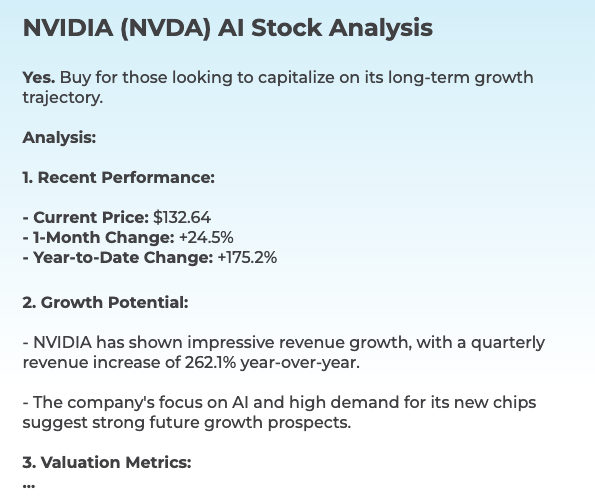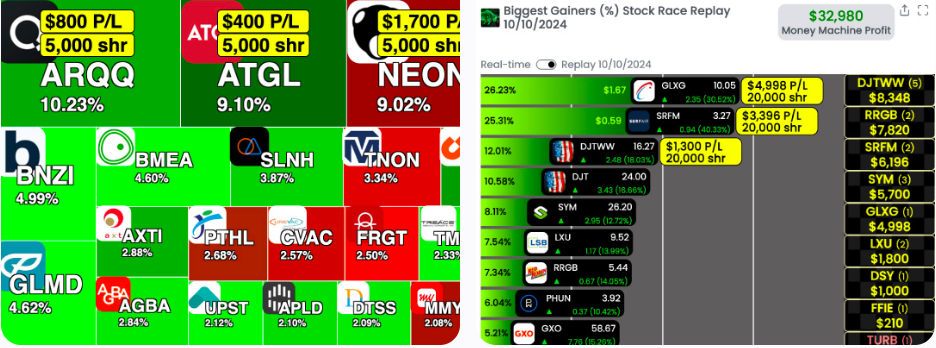20 Great News For Selecting AI Stock Trading Platform Sites
20 Great News For Selecting AI Stock Trading Platform Sites
Blog Article
Top 10 Tips To Assess The Strategy Customization Of Ai Stock Trading Platforms
The ability to customize strategies is an essential feature of AI platform for predicting and analyzing stocks that allow users to adapt the platform to their own specific goals in trading, risk tolerance, and market conditions. A platform that has a range of customizable features can enhance your trading. Here are 10 suggestions for evaluating the customizability of the platforms.
1. Evaluate Pre-Built Strategy Templates
The variety of templates available: Check if the platform provides a variety of already-designed trading strategies (e.g. day trading or swing investing, long-term investment).
User-friendly: Check out how easily you can modify and apply these templates according to your needs.
Performance history: Check if the platform provides historical performance information for the pre-built strategies.
2. Review Customized Strategy Creation
Drag-and-drop: Find platforms which offer drag-anddrop interfaces to create custom strategies.
Options for Coding: For advanced users be sure to check if the platform supports custom programming in proprietary scripting language (e.g. Python, R).
Flexibility: You must be able define the criteria for entry and exit, risk management parameters and other aspects that are essential to your plan.
3. Check for Backtesting Capabilities
Historical data: Make sure that the platform is equipped with enough historical data available to backtest strategies.
Modifiable parameters - Make sure that you have the ability to change parameters (e.g. timeframes, indicators) when backtesting.
Performance metrics - Make sure to see if your platform offers detailed performance indicators (e.g. the winning rate, Sharpe coefficient or drawdown) for all strategies tested back.
4. Evaluate Real-Time Strategy Testing
Paper trading or simulation Check that the platform is compatible with paper trading that allow you to evaluate trading strategies in real-time without risking any money.
Live testing: Test your strategies in live markets with tiny amounts of capital to assess their effectiveness.
Real-time adjustments: Determine if it is possible to adjust strategies according to market conditions.
5. Integrate Integration with Technical Indicators
Indicator libraries: Make sure your platform comes with a comprehensive library of technical tools (e.g. MACD, RSI and moving averages).
Custom indicators. Ensure that you are able to create or use custom indicators to your plan.
Make sure the platform allows you to mix multiple indicators into complex strategies.
6. Check for Risk Management Tools
Stop-loss/take-profit: Ensure the platform allows you to set stop-loss and take-profit levels within your strategies.
Position sizing: Find out if you are able to define rules for position sizing (e.g. fixed amount or a percentage of portfolio) to help manage the risk.
Risk-reward Ratio: Verify that the platform supports setting individual risk-reward limits for strategies and trades.
7. Evaluate Multi-Asset Strategy Support
Asset classes: Make sure the platform can support strategies for various asset classes (e.g. ETFs, stocks, forex).
Cross-asset Strategies: Determine whether it is feasible to create strategies that mix different asset classes.
Market coverage. Make sure the platform covers the markets that you're interested in (e.g. US international, copyright).
8. Review the automation, Execution and Execution
Automated trading. Ensure the platform supports automated execution that is based on predefined strategies.
Order types: Find out whether the platform supports different kinds of orders (e.g., limit, market stop, limit) to execute a strategy.
Latency: Determine whether the platform is able to execute trades with minimal latency, particularly when using high-frequency strategies.
9. Take a look at the Strategy Optimization Tools
Optimization of parameters. Make sure your platform allows you to optimize the parameters of your plan (e.g. Grid search, Genetic algorithms).
Machine learning integration. Check whether your platform is compatible with machine learning to optimize and refine strategies.
Scenario Analysis: Check whether the platform can test strategies across different market scenarios (e.g. bull or bear or volatile).
10. Review Community Feedback and User Feedback
The feedback of users is crucial to assess the performance of a platform.
Community forums - Check for if a platform has a forum that is active and in which users can discuss their unique strategies.
Support resources - Ensure that the platform provides instructions and documents to help users create and enhance strategies.
Bonus Tips
Trial period - Use the trial for free to try out the ability to customize your strategy.
Scalability: Your platform must be able to accommodate ever more complicated trading strategies as you evolve.
Customer support: Check for assistance with strategy-related questions or issues.
Use these guidelines to evaluate the AI stock predicting/analyzing platforms' capacity to tailor strategies. If you do this, you will ensure that you choose a platform that is compatible with your objectives for trading and enables you to create and improve your individual strategies. A platform that is robustly customizable capabilities can allow you to adapt to changing market conditions and enhance your trading performance. Take a look at the recommended ai for investing url for blog info including ai for stock predictions, chatgpt copyright, best ai stock, investing ai, ai for stock trading, ai for trading, chatgpt copyright, using ai to trade stocks, ai investing, ai chart analysis and more.
Top 10 Ways To Evaluate The Accuracy And Scalability Of Stock Trading Platforms Based On Ai
It is important to assess the performance and scalability of AI-driven trading and stock forecasting platforms. This will ensure that they can manage the growing volume of data as well as market complexity and demands from users. These are the top ten ways to determine the scalability of AI-driven stock prediction and trading platforms.
1. Evaluate Data Handling Capacity
TIP: Ensure that the platform has the capacity to process and analyze large datasets.
What is the reason? Scalable platforms should be able to handle increasing amounts of data with no degradation.
2. Test the Real-Time Processing Capabilities
Tip: Check the capability of the platform to handle real-time information streams, such live stock prices, or breaking news stories.
Reason: Delays in trading decisions can result in missed opportunities.
3. Cloud Infrastructure and Elasticity The Cloud Infrastructure and Elasticity
Tips: Make sure that your platform is cloud-based (e.g. AWS, Google Cloud or Azure) and able to dynamically scale resources.
Why: Cloud platforms offer flexibility, allowing systems to scale up or down based on demand.
4. Algorithm Efficiency
Tip: Evaluate the computational efficiency of the AI models (e.g. deep learning and reinforcement learning) used for predictions.
The reason: Complex algorithms can consume a lot of resources So the ability to optimize these algorithms is crucial to ensure scalability.
5. Explore Parallel Processing and Distributed computing
TIP: Make sure to check whether the platform is using frameworks for parallel processing or distributed computing frameworks.
Why: These technologies allow faster data processing and analytics across many nodes.
Examine API Integration & Interoperability
Test the platform’s integration capabilities with external APIs.
What's the reason? Seamless integration with platforms ensures it can adapt to any new sources of data or trading environment.
7. Analyze User Load Handling
You can simulate the high user traffic and observe how the platform reacts.
Why is that a platform that can scale must maintain performance, even as users increase.
8. Assessment of Model Retraining and the Adaptability
Tip: Check how frequently the AI model is retrained and at what rate.
The reason is that models must continuously adapt to the changing market to ensure that they remain precise.
9. Examine fault tolerance and redundancy
TIP: Ensure your platform has failover mechanisms to handle hardware or software failures.
Why is downtime so costly for trading. Therefore, fault tolerance is vital to scaling.
10. Monitor Cost Efficiency
TIP: Take into consideration the cost of scaling up your platform. Consider cloud resources, such as data storage and computing power.
The reason: Scalability shouldn't come at an unsustainable cost, so balancing performance and cost is crucial.
Bonus Tip Future-Proofing
Check that the platform supports advanced technologies (e.g. quantum computing or advanced NLP) and is able to adapt to regulatory changes.
If you focus on these factors you will be able to assess the scale of AI stock prediction and trading platforms, ensuring they are robust, efficient, and ready for future growth. Have a look at the most popular breaking news about ai share trading for website advice including ai options trading, ai stock investing, ai stock predictions, free ai stock picker, best ai stocks, investing with ai, best stock prediction website, ai trading tool, free ai tool for stock market india, best ai stocks to buy now and more.